Compensation Guide for Thyroid Nodules Resulting From AFFF Exposure
The emergence of thyroid nodules as a significant health concern linked to Aqueous Film-Forming Foam (AFFF) exposure has brought to light the intricate relationship between environmental contaminants and endocrine disorders. Given the complex nature of these conditions and the legal landscape surrounding compensation claims, individuals affected by such exposure must navigate a multifaceted process to understand their rights and potential remedies. This guide aims to elucidate the connection between AFFF exposure and thyroid health, offering insights into the legal framework that governs compensation for affected individuals. It serves as a pivotal starting point for those seeking to comprehend the intricacies of their situation and the steps necessary to pursue justice.

Key Takeaways
- AFFF exposure is linked to thyroid nodules due to PFAS chemicals.
- Legal assistance can guide through compensation claims for affected individuals.
- Documentation of AFFF exposure and thyroid health impact is essential for claims.
- Manufacturers like 3M and DuPont may be held accountable in compensation cases.
Understanding AFFF
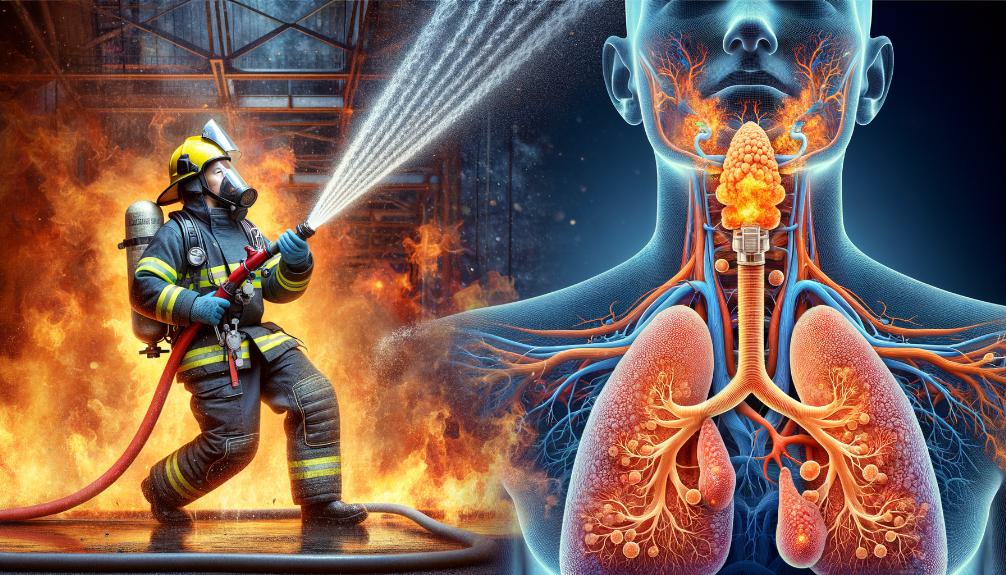
Aqueous film-forming foam (AFFF) is a firefighting agent widely used for its effectiveness in extinguishing flammable liquid fires, yet its composition, containing per- and poly-fluoroalkyl substances (PFAS), has raised significant health concerns, particularly concerning thyroid health. The durable chemical properties of PFAS, which make AFFF highly effective in emergencies, also result in their accumulation in the human body. This accumulation poses a grave concern as it is associated with an increased risk of developing thyroid nodules, a condition that can greatly impact the overall function of the thyroid gland.
Research has shown that exposure to AFFF, and consequently to PFAS, is linked to various thyroid diseases, including the formation of thyroid nodules. These nodules, while often benign, can indicate more serious thyroid conditions or even lead to thyroid cancer if left unchecked. The toxicity of PFAS chemicals is at the heart of these health risks, highlighting the need for those exposed to AFFF to be aware of the potential implications for their thyroid health.
The relationship between AFFF exposure and thyroid health is a critical area of concern. Individuals who have been frequently exposed to AFFF, such as firefighters and military personnel, are at a heightened risk of developing thyroid nodules. This risk underscores the importance of monitoring thyroid health in those with a history of AFFF exposure and understanding the potential long-term health risks associated with PFAS toxicity.
History of AFFF Use
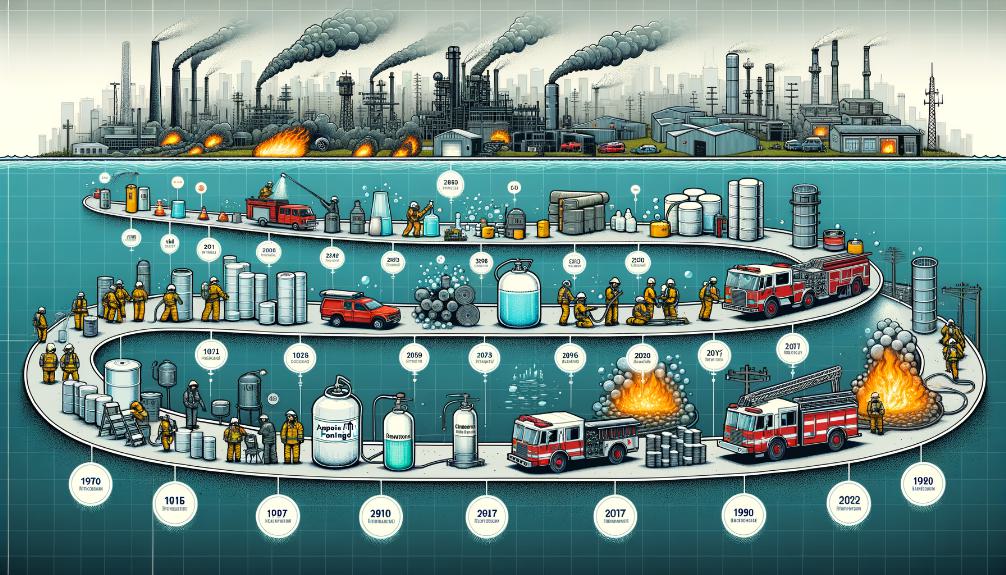
The inception and subsequent adoption of Aqueous Film-Forming Foam (AFFF) in the 1960s marked a significant advancement in firefighting technology, particularly for the U.S. Navy and 3M. Its efficacy in extinguishing jet fuel and petroleum fires led to widespread use across military and civilian firefighting units, embedding AFFF into critical emergency response protocols. However, the presence of PFAS chemicals in AFFF raises serious health concerns, necessitating a closer examination of its deployment history and the implications for those exposed.
AFFF Development Timeline
Developed in 1966 by the U.S. Navy in collaboration with 3M, AFFF was a groundbreaking innovation aimed at enhancing firefighting capabilities against flammable liquid fires. This development marked a noteworthy milestone in the history of firefighting, especially within military operations where the risk of fuel-based fires is high. By creating a film over the fuel surface, AFFF foam effectively extinguished fires, revolutionizing emergency response protocols. Its introduction not only improved safety but also underscored the importance of technological advancements in firefighting. The historical timeline of AFFF underscores its pivotal role in shaping modern firefighting techniques, illustrating a legacy of innovation and dedication to safety in both military and civilian firefighting contexts.
Military and Civilian Applications
Since its inception in 1966, AFFF has been integral to firefighting efforts, seeing widespread application across both military and civilian sectors. Developed collaboratively by the U.S. Navy and 3M, its primary use was for military firefighting, particularly in training areas, airport hangars, and at aircraft crash sites. Despite ongoing efforts to find alternatives by 2025, AFFF remains a staple for emergency response among military and civilian firefighters. Exposure to AFFF can occur not only during active firefighting but also through contaminated personal protective equipment. Given the health risks associated with AFFF exposure, veterans and firefighters who have worked with this foam are advised to seek legal assistance for potential compensation claims.
Health Risks Identified
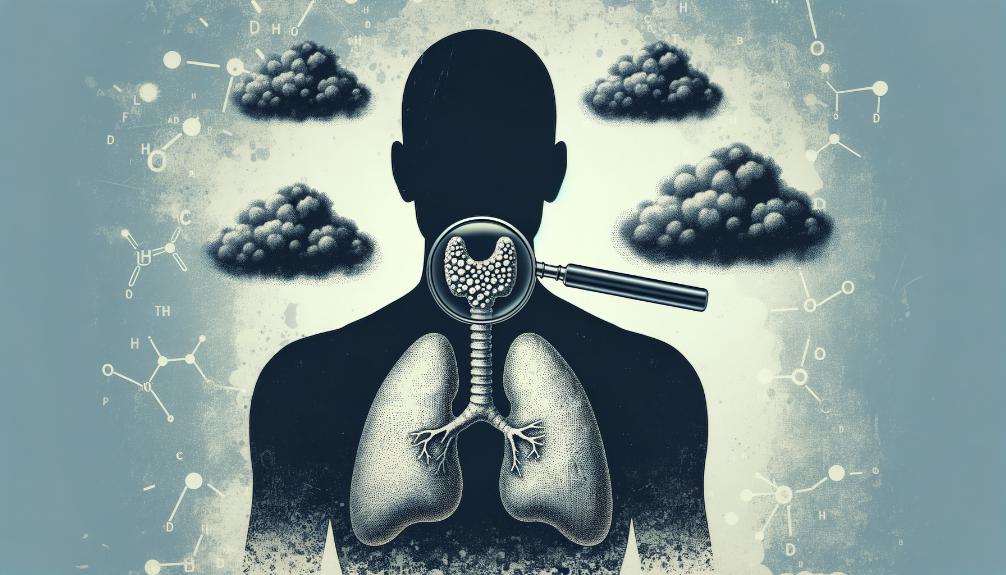
Exposure to PFAS chemicals in Aqueous Film Forming Foam (AFFF) elevates the risk of developing thyroid nodules, a health concern requiring immediate attention. These chemicals, integral to AFFF's fire-extinguishing capabilities, have been associated with adverse health outcomes, prominently including the formation of abnormal growths on the thyroid gland known as thyroid nodules. The link between AFFF exposure and the emergence of these nodules underscores the necessity for those affected to undergo comprehensive medical evaluations.
Thyroid nodules, resulting from AFFF exposure, present a spectrum of potential health implications. While many nodules are benign, the possibility of malignancy cannot be overlooked, necessitating a vigilant approach to diagnosis and management. The process typically involves a series of diagnostic tests, including ultrasound examinations and biopsies, to accurately assess the nature of the nodules. This meticulous medical evaluation is not only crucial for the individual's health but also plays a pivotal role in the pursuit of compensation claims.
For individuals seeking compensation for thyroid nodules attributed to AFFF exposure, the path is marked by the need for thorough documentation. This encompasses a detailed exposure history to PFAS chemicals and comprehensive medical records that substantiate the diagnosis and treatment of the nodules. The intricacies of compensation claims emphasize the importance of understanding the risk posed by AFFF exposure and the subsequent steps towards obtaining a rightful claim, grounded in a solid foundation of medical evaluation and diagnostic testing evidence.
Thyroid Nodules Link

Understanding the connection between AFFF and thyroid nodules is critical, as these abnormal growths on the thyroid gland are increasingly being traced back to exposure to PFAS chemicals present in firefighting foams. The link between AFFF exposure and the development of thyroid nodules highlights the health risks posed by these endocrine-disrupting compounds. PFAS chemicals, known for their persistence in the environment and the human body, have been identified as a key factor in the emergence of thyroid nodules among individuals exposed to AFFF.
The detection of thyroid nodules is primarily achieved through imaging tests, such as ultrasounds, which allow healthcare providers to assess the nodules' size, shape, and characteristics. These nodules may not always present with symptoms; however, when symptoms such as neck swelling, difficulty swallowing, or hoarseness do occur, they necessitate a thorough evaluation to rule out potential malignancy. The endocrine-disrupting properties of PFAS chemicals can interfere with thyroid function, leading to the growth of these nodules and, in some cases, contributing to the development of thyroid cancer.
Monitoring individuals with thyroid nodules resulting from AFFF exposure is crucial. Regular follow-up and imaging tests are essential to detect any changes in the nodules that may indicate a progression toward malignancy. This vigilant approach ensures that any shifts in the nodules' behavior are promptly addressed, potentially leading to early intervention and treatment. The link between AFFF exposure and thyroid nodules highlights the importance of recognizing and managing the health implications associated with exposure to PFAS chemicals.
Legal Framework Overview

Navigating the legal framework for securing compensation due to thyroid nodules from AFFF exposure is intricate, requiring a clear understanding of regulatory compliance standards and the compensation claim process. Successful claims hinge on substantiating the link between AFFF exposure and thyroid nodule development, guided by stringent legal criteria. This section will elucidate the steps involved in filing a compensation claim, alongside the regulatory standards that underpin these processes.
Regulatory Compliance Standards
Addressing the regulatory compliance standards for AFFF exposure, the legal framework specifically targets the phased-out use of PFAS chemicals in firefighting foams by October 2024 to mitigate health risks. This initiative underscores the imperative to monitor and control the presence and utilization of hazardous substances like PFAS in AFFF, with a particular emphasis on safeguarding public health. Suppliers are now mandated to certify the absence of intentionally added PFAS in their products and to undertake rigorous foam testing to ascertain compliance. This comprehensive approach not only ensures the safety of individuals potentially exposed to AFFF but also places a considerable onus on manufacturers to uphold accountability for the production of firefighting foams, aligning with the overarching goal of minimizing health risks associated with PFAS exposure.
Compensation Claim Process
Initiating a compensation claim for thyroid nodules due to AFFF exposure necessitates a clear demonstration of the link between the condition and PFAS chemicals found in firefighting foams. This process involves meticulously gathering evidence that unequivocally connects AFFF exposure to the development of thyroid nodules. Legal claims in this arena demand a comprehensive understanding of the legal framework, which is pivotal in proving the relationship between exposure and illness. Applicants seeking compensation must present detailed documentation, including medical records, to substantiate claims for medical expenses, lost wages, and pain and suffering. Given the complexities of these cases, securing legal assistance is imperative. Lawyers specializing in such matters can navigate the intricate process, ensuring that all necessary evidence is presented effectively to support the compensation claim.
Identifying Eligible Victims
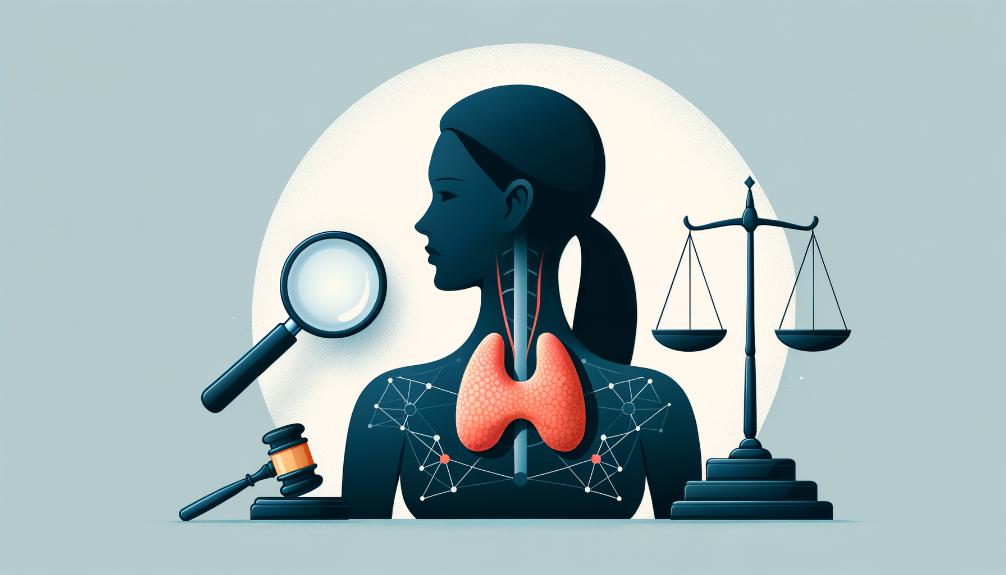
Identifying victims eligible for compensation due to thyroid nodules from AFFF exposure requires the establishment of a clear link between their condition and exposure to PFAS chemicals. This critical step involves a meticulous review of medical documentation and environmental exposure history to substantiate claims. Thyroid nodules, which are abnormal growths in the thyroid gland, have been increasingly associated with long-term exposure to toxic substances, specifically PFAS chemicals found in AFFF (Aqueous Film Forming Foam) used for firefighting and training purposes.
For individuals who have developed thyroid nodules as a direct consequence of AFFF exposure, the path to compensation involves demonstrating the causal relationship between their health condition and PFAS contact. Medical documentation plays a pivotal role in this process, as it provides concrete evidence of the presence and likely cause of thyroid nodules. This documentation often includes medical records, diagnostic reports, and expert opinions linking PFAS exposure to thyroid gland abnormalities.
Eligibility for compensation encompasses not only medical expenses incurred due to the treatment of thyroid nodules but also covers lost wages and pain and suffering endured by the victims. To navigate the complexities of compensation claims, legal assistance becomes indispensable. Lawyers specializing in environmental exposure cases offer the necessary guidance and support to victims, ensuring that their claims are robustly presented and defended against the manufacturers of AFFF. Legal professionals adept in handling such cases can greatly enhance the likelihood of securing rightful compensation for affected individuals, thereby providing them with a semblance of justice for their suffering and financial losses.
Evidence Collection Steps
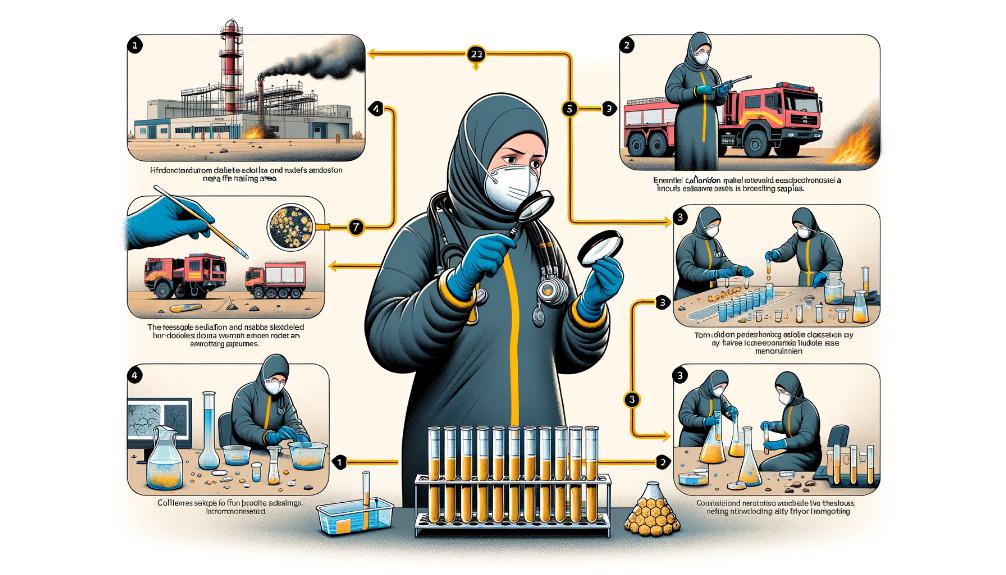
Having established the importance of linking AFFF exposure to thyroid nodules for compensation eligibility, the next critical step involves the meticulous collection of evidence to support such claims. This phase is foundational in building a strong case, requiring both legal and medical diligence to navigate successfully.
Firstly, victims should gather all medical records that document the diagnosis of thyroid nodules, ensuring these records indicate the timing following AFFF exposure. This medical documentation serves as the cornerstone of the evidence, illustrating the direct impact on health. Additionally, obtaining detailed documentation of AFFF exposure is crucial. Employment records, military service documents, or any official records that can substantiate exposure periods are vital. This evidence bridges the gap between the condition and its cause.
Furthermore, evidence of treatment for thyroid nodules, including details of surgeries or medications, underscores the severity and the resultant healthcare burden. Such documentation not only supports the claim but also highlights the financial and emotional toll on the victim.
Expert opinions or medical reports that can directly link thyroid nodules to AFFF exposure play a critical role in reinforcing the claim. These expert insights provide the scientific foundation that connects the condition to the exposure, making them indispensable in the evidence-collection process.
Lastly, securing documentation of any symptoms or health complications stemming from the thyroid nodules attributed to AFFF exposure further strengthens the case. This comprehensive approach to evidence collection ensures that all facets of the impact are considered, paving the way for a compelling compensation claim.
Filing Your Claim

Transitioning from gathering evidence to the next critical step, claimants need to understand the process of filing their claim for compensation due to thyroid nodules from AFFF exposure. This phase encompasses understanding the eligibility criteria, preparing the necessary documentation, and navigating the claim submission process efficiently. Our discussion will equip you with the knowledge needed to proceed with confidence and precision.
Eligibility Criteria
To file a successful claim for compensation due to thyroid nodules from AFFF exposure, an individual must first secure a confirmed diagnosis of the condition. Eligibility hinges on medical records that establish a direct link between AFFF exposure and the development of thyroid nodules. These records must convincingly demonstrate the extent of exposure and its detrimental impact on thyroid health. Veterans and firefighters are among those who, due to their professional exposure to AFFF, may find themselves eligible for compensation. Navigating the complex landscape of eligibility criteria requires expert legal assistance. Such assistance ensures that all necessary documentation is accurately compiled and submitted, enhancing the likelihood of a successful compensation claim for thyroid nodules resulting from AFFF exposure.
Documentation Requirements
When filing a claim for compensation due to thyroid nodules from AFFF exposure, the collection and organization of comprehensive documentation are paramount. It's essential to have detailed medical records that document your diagnosis and the treatment of thyroid nodules. These records form the backbone of your claim, demonstrating the medical basis for your compensation request. Furthermore, evidence linking your condition directly to AFFF exposure is crucial. This may include a detailed exposure history, supplemented with medical opinions that support this connection. Relevant employment records are also important, especially for those exposed to AFFF as firefighters or military personnel. Including expert opinions or reports that reinforce the link between AFFF exposure and thyroid nodules can significantly strengthen your claim, ensuring all documentation is well-organized and readily accessible.
Claim Submission Process
Having gathered and organized all necessary documentation, the next critical step in seeking compensation for thyroid nodules due to AFFF exposure involves efficiently navigating the claim submission process. This stage requires meticulous attention to detail in presenting your case. Your claim should include comprehensive medical records that document the diagnosis and treatment of your thyroid nodules. It is crucial to detail your AFFF exposure history, highlighting the duration, frequency, and intensity of exposure. Incorporating expert opinions or medical reports that establish a link between your thyroid nodules and AFFF exposure will strengthen your case. Additionally, submit documentation that reflects the impact of thyroid nodules on your quality of life and underscores the necessity for ongoing medical care. Seeking legal assistance can be invaluable in guiding you through the claim submission process, ensuring that all aspects are thoroughly addressed, and enhancing your prospects of securing compensation.
Manufacturer Accountability
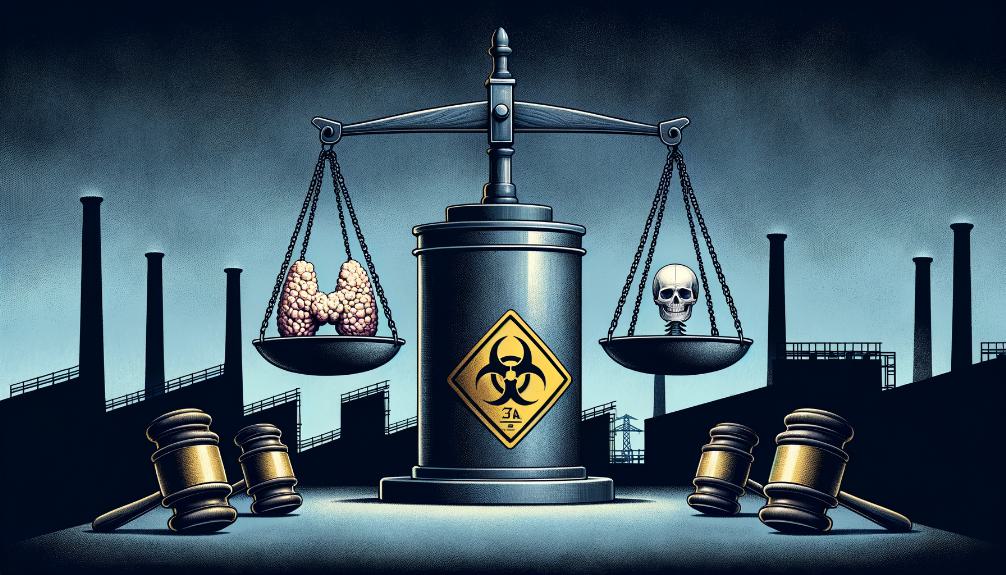
Several manufacturers, including 3M, Tyco Fire Products, and DuPont, face legal scrutiny for their role in producing aqueous film-forming foam (AFFF) that contains per- and polyfluoroalkyl substances (PFAS), despite knowledge of its potential health risks. This group of manufacturers, which also includes Chemguard, National Foam, and Buckeye Fire Equipment, has been at the center of allegations suggesting they continued to manufacture and distribute AFFF aware of its detrimental health impacts. This has led to considerable litigation efforts aimed at holding these entities accountable.
The legal actions taken against these manufacturers are not just about compensation; they are about accountability for the health risks associated with AFFF exposure. Litigations centralized in the United States District Court for the District of South Carolina have spotlighted manufacturer accountability as a crucial aspect of the broader conversation on AFFF and its effects on human health. These cases underscore the importance of responsibility from those who produced and sold AFFF, knowing the risks tied to PFAS exposure.
Holding manufacturers responsible is a pivotal step in ensuring that those affected by AFFF exposure receive the compensation they deserve. This accountability is not merely a legal formality but a moral imperative to address the health issues stemming from AFFF use. As litigation continues, the focus on manufacturer accountability highlights the broader need for corporate responsibility in protecting public health, particularly concerning the production and sale of substances known to pose health risks.
Potential Compensation Types
Exploring the landscape of potential compensation types for thyroid nodules from AFFF exposure is crucial for victims seeking redress. This section will provide an overview of legal settlements, outline the procedures for filing insurance claims, and discuss eligibility for government assistance programs. Understanding these avenues is essential for securing the comprehensive compensation that victims deserve.
Legal Settlements Overview
Victims of thyroid nodules due to AFFF exposure may be eligible for various types of compensation, including medical costs, lost wages, pain and suffering, and punitive damages. Legal settlements for these conditions aim to cover comprehensive medical expenses, which can range from diagnostic testing to surgical treatments necessitated by the thyroid nodules. Additionally, individuals affected by thyroid nodules resulting from exposure to AFFF may secure compensation for lost wages, acknowledging the economic impact of their health-related work absences or disabilities. Moreover, victims can receive compensation for the physical and emotional distress caused by their condition. Importantly, settlements may also include punitive damages, holding manufacturers accountable for negligence in the production and distribution of the hazardous firefighting foam. Through legal assistance, affected individuals can pursue the full scope of compensation to address the multifaceted damages incurred.
Insurance Claim Procedures
Navigating the complexities of insurance claim procedures for thyroid nodules due to AFFF exposure, individuals can access various forms of compensation, including coverage for medical expenses, lost wages, and pain and suffering. Insurance claims for thyroid nodules resulting from AFFF exposure are designed to address the financial and emotional toll of the condition. They may include compensation for medical expenses related to diagnosis, treatment, and ongoing monitoring. Additionally, individuals can seek compensation for lost wages due to time off work for medical appointments and recovery periods. The claims process also acknowledges the emotional distress caused by thyroid nodules, offering compensation for pain and suffering. Legal assistance is often crucial in navigating these procedures to ensure that individuals receive appropriate compensation, including coverage for future medical care and potential complications arising from thyroid nodules.
Government Assistance Programs
For veterans who have developed thyroid nodules as a result of AFFF exposure, government assistance programs such as VA Disability Compensation may offer substantial financial relief. This program provides benefits based on the severity of the condition and its impact on the veteran's daily life. Veterans with thyroid nodules linked to their service, recognized as a service-connected disability, are eligible for this compensation. The VA assesses the extent of disability caused by thyroid nodules due to AFFF exposure, determining the level of benefits. Additionally, seeking legal assistance can be crucial for veterans navigating the complexities of obtaining rightful compensation. Legal experts can guide veterans through the application process, ensuring they receive the benefits they deserve for their service-connected health issues.
Lawsuit Progress Updates
Recent developments in legal proceedings highlight the increasing acknowledgment of thyroid nodules as a significant health issue related to AFFF exposure. This growing recognition is a critical step forward for those affected, as lawsuits concerning this matter are gaining traction in courts across the nation. Legal developments have begun to solidify the link between AFFF exposure and the development of thyroid nodules, offering a new avenue for compensation claims.
As court proceedings unfold, the focus is intensifying on the specific health consequences of AFFF exposure, with thyroid nodules taking center stage. This shift is partly due to the mounting evidence presented in these cases, illustrating the powerful impact AFFF chemicals can have on thyroid health. The legal system's evolving understanding of this connection is paving the way for more robust compensation efforts targeted at individuals suffering from thyroid nodules as a result of AFFF exposure.
Furthermore, the dedication to addressing the health ramifications of AFFF exposure through legal channels signifies a notable development in the fight for justice and compensation for affected parties. As lawsuits continue to progress, they not only aim to secure financial compensation for the victims but also push for greater public awareness and regulatory changes regarding the use and handling of AFFF.
Settlement Amount Factors

Understanding the factors that influence settlement amounts for thyroid nodules caused by AFFF exposure is crucial for affected individuals seeking compensation. Settlement amounts for this specific health issue hinge largely on the severity of the condition itself. This severity is assessed based on various criteria, including the individual's medical expenses incurred due to the condition, lost wages resulting from inability to work, and the anticipated costs of future treatment and care. These factors collectively play a role in determining the financial compensation awarded to victims of AFFF exposure.
Moreover, the extent of exposure to AFFF is another critical factor that influences settlement amounts. The duration and intensity of exposure can exacerbate the health consequences, thereby affecting the overall compensation. Documented evidence linking the exposure to the thyroid nodules and demonstrating the resultant damages is indispensable for substantiating claims. This evidence not only helps in establishing a direct correlation between AFFF exposure and the thyroid condition but also in quantifying the financial, physical, and emotional toll on the affected individuals.
Consultation with legal experts is advised to navigate the complexities of such cases. Legal professionals can offer invaluable insights into the factors impacting settlement amounts and assist in gathering the requisite documentation to support claims. Their expertise ensures that individuals fully understand their rights and the potential outcomes of their compensation claims, facilitating a more informed decision-making process regarding the pursuit of legal action for thyroid nodules resulting from AFFF exposure.
Seeking Legal Assistance

Navigating the complexities of legal proceedings for compensation due to thyroid nodules from AFFF exposure necessitates the expertise of qualified attorneys. These legal professionals possess the necessary knowledge and skills to effectively address the intricacies surrounding cases of AFFF exposure. Their involvement is paramount in ensuring that individuals receive the justice and compensation they deserve. The process of seeking legal assistance begins with selecting attorneys who have a proven track record in handling similar environmental or health-related litigation.
Qualified attorneys play a critical role in gathering and presenting the required documentation and evidence to substantiate the claim for compensation. This includes meticulously compiling medical records that detail the diagnosis and treatment of thyroid nodules directly linked to AFFF exposure. Legal representatives understand the importance of establishing a clear connection between the exposure and the health condition to build a strong case.
Furthermore, skilled lawyers are adept at navigating the legal framework to advocate on behalf of their clients. They engage in negotiations or court proceedings with the aim of securing fair compensation for the harm suffered. This compensation is vital for covering medical expenses, lost wages, and other related costs that individuals affected by thyroid nodules due to AFFF exposure may face.
Deadlines and Timelines

Deadlines for filing claims related to thyroid nodules from AFFF exposure are critical to observe, as they vary based on legal requirements and individual circumstances. These deadlines are pivotal in the process of seeking compensation, as statutes of limitations can restrict the timeframe within which legal action may be initiated. Understanding these specific timelines is crucial to maintaining eligibility for compensation.
The statutes of limitations for filing claims related to thyroid nodules resulting from AFFF exposure differ by jurisdiction. This means that the allowable period to file a claim can vary greatly from one area to another, emphasizing the importance of timely action. Failure to adhere to these deadlines can result in a complete forfeiture of the right to seek compensation for harm suffered due to AFFF exposure.
Given the complexity of determining applicable deadlines, securing legal assistance early in the process is advisable. Legal professionals specializing in AFFF exposure cases are well-versed in navigating the intricacies of statutes of limitations and can provide invaluable guidance. They ensure that all necessary steps are taken within the appropriate timelines, thereby safeguarding the potential for compensation.
Encouraging Victim Action

Recognizing the critical nature of adherence to legal deadlines, it is equally imperative for victims of thyroid nodules from AFFF exposure to proactively seek legal representation to safeguard their rights and pursue the compensation they are due. Timely action is not just a procedural step; it is a necessary move to ensure that victims can access the necessary resources for medical treatment and secure the financial support essential for their well-being. The path to compensation is fraught with complexities, and navigating the legal landscape requires expertise that only seasoned attorneys can offer.
For individuals suffering from thyroid nodules as a direct consequence of AFFF exposure, understanding the scope of their legal rights is the first step toward achieving justice. The legal system offers a mechanism for redress, but it requires victims to step forward and claim their space within it. By seeking legal assistance promptly, victims can enhance their chances of securing a fair compensation package that covers their medical expenses, suffering, and any other related costs.
Encouraging victims to explore their legal options is not just about starting a claim process; it's about empowering them to stand up against the negligence that led to their condition. Every victim who takes action strengthens the case for accountability and helps to highlight the broader implications of AFFF exposure. Therefore, it is of paramount importance for victims of thyroid nodules linked to AFFF exposure to understand that their actions can lead to obtaining the justice and support they rightfully deserve, reinforcing the notion that their health and rights are of utmost importance.
Frequently Asked Questions
What Is the Average Payout for the AFFF Lawsuit?
The average payout for an AFFF lawsuit varies enormously, influenced by the severity of health complications and exposure levels. Settlements can range from a few thousand to several million dollars, reflecting individual case differences.
What Is the VA Disability Rating for Afff?
The VA disability rating for conditions related to AFFF exposure, including thyroid nodules, is determined by evaluating the severity and impact on the veteran's daily life, with specific ratings contingent upon individual case assessments.
Can AFFF Cause Thyroid Problems?
Exposure to Aqueous Film Forming Foam (AFFF) containing PFAS chemicals has been linked to thyroid problems, including thyroid nodules. Research indicates PFAS's ability to disrupt thyroid function, potentially leading to these health issues.
Who Qualifies for the AFFF Lawsuit?
Individuals potentially qualifying for the AFFF lawsuit include firefighters, military personnel, and residents near contaminated sites who have developed thyroid nodules due to exposure to PFAS chemicals in Aqueous Film-Forming Foam. Legal consultation is advised.
Conclusion
The association between AFFF exposure and the development of thyroid nodules underscores the necessity of heightened awareness and proactive measures. The toxicological impact of PFAS chemicals on thyroid health necessitates comprehensive legal and medical strategies to support affected individuals. This guide serves not only as an educational resource but also as a call to action for those experiencing health repercussions. The emphasis on legal recourse highlights the critical path toward seeking justice and compensation for those adversely impacted by AFFF exposure.



